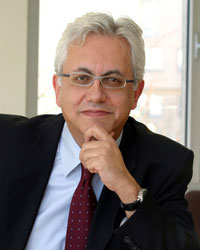 by Khalil Rouhana, Director, Digital Content & Cognitive Systems European Commission, DG Information Society and Media
by Khalil Rouhana, Director, Digital Content & Cognitive Systems European Commission, DG Information Society and Media
The ‘European Competitiveness Report 2010’ identified the cultural and creative industries as one of Europe’s most dynamic sectors, accounting for 3.3% of EU GDP and 3% of employment. Beyond this important contribution to GDP, the creative and cultural sectors are indeed a vehicle of significant lifestyle changes and progress, including the development of modern skills, adapting teaching and learning and inter-generational and intercultural dialogues.
Digital technologies continue to radically transform our approach to creativity and culture. They modify not only the way we access and preserve cultural assets but they also provide us with unique tools to better create and communicate. ICT has become a major vehicle for enriching our "creative capital" that underpins our societal vitality, our economic growth and ability to compete on a global scale.
This is why digital content, is one of the important policy areas of the Digital Agenda for Europe (DAE). The policy aim is to strengthen Europe’s cultural creativity, develop further the internal market for digital content, preserve our cultural resources and make them widely accessible to all citizens.
The DAE approach consists of three interlinked pillars:
1. Creating the best framework conditions for the creation and diffusion of cultural assets including copyright issues and open access: A new copyright strategy has been suggested by the Commission in May 2011 that clarifies the legal framework for digitizing cultural heritage, making it accessible to all and unlocking the potential for its re-use. It includes notably a legislative proposal on orphan works in view of facilitating the digitization of millions of works that are in copyright, but for which the right-holders cannot be found.
2. Supporting the effort of digitization of all European cultural content and providing a platform for aggregating digitized cultural resources with an easy and single access point: Digitizing our cultural heritage is a huge task. A recent report has estimated the cost of digitizing our entire cultural heritage at 100 billion euro, highlighting the need for careful planning, since public money is scarce and duplication of effort should be avoided. At the same time the sheer magnitude of the effort calls for private investments in digitization, not least because the private sector will hugely benefit from a thriving content ecosystem in Europe.
A central pillar in Europe's strategy in this area is Europeana, Europe's digital library, archive and museum. It aims at making Europe's cultural resources and scientific records easy to use for leisure, work or studies. It is also destined to act as a hub for the creative industries, facilitating the use of cultural resources in innovative products and services. Europeana currently gives direct access to more than 19 million digitised objects from more than 1,500 cultural institutions. It will reach 30 million by 2015.
3. Financing R&D and innovation: In 2011-12, the Commission is investing around 100 M€ per year in technologies for digital content and cultural heritage. Support goes to research and innovation in tools for content creation, access and preservation. It targets application areas spanning from cultural arts to entertainment and education. The underpinning technologies include computer vision, advanced graphics, simulation and visualization tools, 3D immersive environments, cognitive systems, multi sensorial interactions and semantic based content search.
The EU investment has helped to build a solid research community bridging the gap between traditional ways of dealing with cultural heritage and the opportunities offered by ICT. For example, The EU-funded project V-City - The Virtual City (http://vcity.diginext.fr) aims at an innovative system for reconstructing, visualizing and exploiting complete, large-scale and interactive urban environments. The technology (combining computer vision, 3D modelling and virtual reality) can be used by archaeologists and other cultural heritage professionals, or for business intelligence. Another example is the EU-Funded project eCUTE (http://ecute.eu/) developing a tool for cultural understanding and empathy in children and young adults. It uses a view of culture based on intercultural sensitivity model. In terms of structuring and coordination, the Network of Excellence GaLA on Serious Games for education and training aims at building a European Virtual Research Centre on Serious Games (http://www.elios.dibe.unige.it/gala/).
By combining policy, research and innovation, the DAE actions aim at making our cultural heritage a driver for innovation and creativity and to enable the wider diffusion of European culture and values worldwide. "We only live to discover beautiful things, all the rest is just waiting..." These words of the poet explain well our continuous quest to create and to access and preserve cultural resources, these millions of "beautiful things" for generations to live for.
The views expressed in the article are the sole responsibility of the author and in no way represent the view of the European Commission and its services.
{jcomments on}









